By Robert Togneri, Lochmaben, February 2024
Medieval > Carruthers > Kennedy > Gordon > Johnstone > Army Camp > POW > Sad End
Halleaths is the site of a former mansion and estate in Lochmaben Parish, Dumfriesshire, on the right bank of the Annan, 1¾ mile south-east of Lochmaben. The name has evolved from Hallathis in the 14th century, Havolathis in the 15th century to Hallaiths in the 17th and Halleaths in the 19th which remains the accepted spelling. The estate once encompassed the lands of Braidholm (now Broadholm on the left bank of the Annan), Part of Fourtowns, Priestdykes and Part of Greenhill1.
In 1320, for loyal services to the Bruces as Lords of Annandale, Robert the Bruce2 gave a charter of lands beginning the line of Carruthers de3) Mouswald and these lands included Hallaiths, however the first mention of Halleaths is contained in an Act of Edward Balliol4 (1283-1364), King of Scots (1332-56) dated August 28, 1334, when he awarded the lands of Thomas (The Clerk) Carruthers5 de Hallathis to Henry de Percy6.
During the fifteen years between 1409 and 1424, the Carruthers family were the recipients of numerous grants of land from the powerful Archibald, Earl of Douglas7.
The next charter was granted at Lochmaben on December 4, 1411, to “Simon of Carrutherys” and comprised “his tenement of Mouswald, with the pertinents, within his forest of Daltoun, his lands of Appultrethwate, with the pertinents, lying in the lordship of Anandale, for service done and to be done to the granter, which . . . the foresaid Simon had resigned in presence of many noblemen in the justice eyre of Anandale, held at the town of Louchmabane.”
Their followed numerous other grants, the most relevant here is on August 20, 1452, the King, James II, granted to John de Carruthers father of Simon and Captain of the Royal Castle of Lochmaben[Sometimes referred to as Constable or Keeper of the Castle] “…the lands of Mousfald, Loganetenement, Medilby, Dronnok, Ellirbek, Hatilland Hill, Cummertries, Hoddome, Tunnergath, Hallathis, Cumlungand, Hultvhate, Stanrase and Wamfray . . . which belonged to the said John heritably and were resigned by him in the King’s hands at Edinburgh : all which the King unites into one free barony to be called the barony of Carutheris”.
In 1454, Lochmaben Castle was taken by the Johnstones from John de Carruthers of Mousewald by force of arms. John de Carruthers was at that time the Captain of the castle.
On March 3, 1472, the sons of John de Carruthers, Simon, the brother of Archibald Carruthers (1430-1462) de Mouswald8, brought an action against John Maxwell (1430-1484)9, Steward of Annandale, for the wrongful withholding of Hugh Kennedy – a minor placed in Simon’s charge by consent and that John Maxwell claimed to be the tutor.
In 1472, Simon laid an accusation before the Court of the Lord Auditors10 against Hugh Kennedy for the performance of an indenture made between him and the said Simon and against Thomas Kennedy for the wrongful withholding of 40 merks lawfully obtained and against numerous persons who, in company with John Maxwell, had broken the Sovereign’s protection.
From a record dated May 18, 1474, Simon lost his case in that he had to give up his charge, over two years after the original action.
The Lord Auditors judgement was: “…for the wrongful troubling of the said Simon in the holding of his court upon his lands of “Havolathis” and for the wrongful invasion of his fair mansion with “multitude of men of armys” and for the breaking of the Sovereign’s protection. However it was also decreed that Hugh Kennedy pay to Simon Carruthers for his cost and expense at due times £20 and ordained letters be written to “distrain11 his lands and goods therefor”. 12
Simon, who was Warden13 14 of the West March15 was killed in 1484 at the Battle of Kirtle16 which is also known as the Battle of Lochmaben or Albany Raid17. He was survived by his three daughters – Elizabeth, Margaret and Janet. Elizabeth being the eldest became Elizabeth of Halleaths and on her marriage to Hugh Kennedy, the minor formerly Simon’s ward, the ownership moved into the Kennedy family line.
In 1565 John Johnstoun, the second Baron Newbie, was returned the eldest lawful heir to his father and mother. The witnesses to the retour18, among others, included are John Carruthers of Holmends (Newbie’s father-in-law), John Kennedy of Halleath, Adam Johnstoun de Beatok and John Johnstoun de Elsieschellis19.
As recorded inthe Land Tax Rolls of 164520 the lands of Hallaiths passed on from Harbert Kennedy on his death. The feu21 duties that were due were reduced by an amount payable to the late Earl of Annandale which would suggest that the rights to the lands of Hallaiths were granted to the Kennedys by Annandale. Indeed the Kennedy22 family appear to have come from Carrick in Ayrshire and were connected to the Bruce family who were the first Lords of Annandale, having supported Robert the Bruce during the Wars of Scottish Independence23.
In 1672 the Johnstouns of Halleaths appeared when the heiress, Agnes Johnstoun married John Kennedy owner of Halleaths. However after their marriage the lands became mortgaged to a Johnstoun of Priestdykes.24
Halleaths was a small estate situated about a mile from Lochmaben by the side of the River Annan. During the 17th and 18th Centurys the Laird was often a bailie on Lochmaben Town Council and thus a man of considerable influence in the community.
A letter to Lord Annandale from Kennedy of Halleaths in 1702 reminds him that Archibald Johnston25 of Beirholm’s second son is idle, “which is ill- breeding for a young man, and is not his choice. Your lordship posted his brother in Dumfries, and I hope he shall do very well in it.” The writer suggests that there is a vacancy among the macers of the King’s Guard26 at Edinburgh. “If your lordship would get that for Archie it would be a means of subsistence, and put him in a better capacity to be a servant to your lordship and your family.“27 In 1715, during the Jacobite rising, Johnstone of Broadholm was one of the sheriffs deputes at Dumfries28
During the 18th century, the Kennedys of Halleaths face a number of legal challenges. In 1721, Janet Forsyth, widow of William Johnston, in conjunction with John Forsyth, brought an action against George Kennedy of Halleaths and obtained the life rent of Over Halleaths(believed to be Innerfield farm).
In 1739, John, Samuel, David and Nicolas Johnston, children of the late George Johnston, drew the rents of the lands of Halleaths, while in 1740, William Johnston, surgeon in Dumfries, brought an action against Herbert Kennedy in Halleaths and another the same year against Thomas Johnston of Clochrie.
However, toward the end of the eighteenth century, the fortunes of the Kennedy family slumped, and the estate was bought in 1773 by Major Gilbert Gordon.

Major Gilbert Gordon (1722-1789) was the son of Archibald Gordon (1691-1754) and Janet Young (Abt.1659-1719) and married Margaret Stewart, daughter of Captain Stewart. He lived at Halleaths and is reputed to have been a friend of the poet Robert Burns29, a regular visitor to Lochmaben. Burns and Gordon were both excisemen and with an inclination to write poetry. Gordon had an epistle “On the Cultivation of Taste” published in the first volume of Donaldson’s “Collection of Original Poems by Scotch Gentlemen30”.
The family Gordon have their own crest which is shown on the right31
Crest: From a Bookplate of Gordon of Halleaths States, ‘Gordon of Halleaths‘ with the motto ‘Dread God‘ features a shield with three boars heads, a crescent, a roundel, a helmet, a crest with a hand holding a sword
Their son, Archibald Gordon (1772-1841), inherited Halleaths and lived there with his wife, Anne Ponsonby and their children, among whom was a son, also called Archibald.
Archibald Gordon set about rebuilding the family home. One of the stonemasons who worked on the house was to become the Reverend Alexander Scott32. He was ordained by the Presbytery of Lochmaben as collegiate minister in the Scottish Church of Rotterdam33. In 1795 he returned and was presented and admitted to New Church, Dumfries, and translated to St. Michael’s in 180634. About this time he became a residential tutor to the five children of the proprietor.
Archibald Gordon’s name appears in the seat letting lists of Lochmaben Parish Church35 in 1820 and in Pigot and Slater’s Directory of 1825-2636 but the edition of 1837-3837 records the owner as Andrew Johnstone (1798-1857) who appears to have purchased the property when it was advertised by the agents were Gordon and Primrose (now Primrose and Gordon) in the Dumfries Weekly Journal of 10th February 1824 as follows;
A Most Delightful Country Residence for a genteel family
To be let and entered to at Whitsunday 1824. The Mansion House of Halleaths
with garden, orchard and well stocked pigeon loft.
Common offices all in excellent order with 60 acres of rich old grassland surrounding the house.
Presumably the old mansion house stood on the site of the new house built by Johnstone in 1843 with the fortune he had acquired through his connection with the Jardine Matheson Company38. Johnstone also appears to have purchased the estate as an investment as he allowed the Gordon family to continue to live there,
In 1831 the house is listed in the land tax rolls as occupied by Archibald Gordon of Halleaths with tax due on the Lands and Estate of Halleaths, Braidholm (now Broadholm on the opposite bank of the Annan, Part of (the Royal) Fourtowns, Priestdykes and part of Greenhill39. The land tax came to 551 merks40. (about £2,057)
In 1832, Jardine, Matheson & Co.41, later Jardine, Matheson & Co., Ltd., the forerunner of today’s Jardine Matheson Holdings, was a Far Eastern company founded by Scotsmen William Jardine and James Matheson as senior partners. Trafficking opium in Asia, while also trading cotton, tea, silk and a variety of other goods, from its early beginnings in Canton (modern-day Guangzhou), in 1844, the firm established its head office in the new British colony of Hong Kong, then proceeded to expand all along the China Coast. The Johnstone family were also involved in its operation.
In 1842, after the death of Alexander Gordon, Halleaths was occupied by Dr Andrew Johnstone (1798-1857), who erected a fine sandstone mansion with a beautiful stable block in which to house the horses, which were the family’s abiding passion.
Dr Jack Wilson42 a talented local historian, in his history of Lochmaben, suggests the nearest Lochmaben has come under a benevolent manorial interest was, after the building of the new mansion at Halleaths by Dr Andrew Johnstone in 1843.
However, one has to wonder if it was in Lochmaben residents interests for him to oppose a main railway line through Lochmaben. His action delayed the arrival of the railway in Lochmaben until, in 1847, the railway from Carlisle to the north was routed through Lockerbie instead of Lochmaben, largely, it was said, because of the refusal of the Laird of Halleaths to allow its passage over his land. The branch line from Lockerbie to Dumfries, through Lochmaben, opened in 186343.
After building it Dr Johnstone moved into Broadholm across the river and his brother John Johnstone (1822-1884) occupied Halleaths where he pursued his passion for horses.
In 1869, John Johnstone won the Derby44 with Pretender45, which also won the 2000 Guineas46 race the same year. Many other fine horses came from these stables. After he died in 1884 the estate passed to his son, Andrew John Scott Johnstone (1858-1901).
In 1894, the Laird of Halleaths constructed a small reservoir on the hill above Thorniethwaite farm and piped this water to Halleaths and across the River Annan to supply Dryfeholm and Castlemilk. The pond now serves as a refuge for waterfowl and can be located at grid reference NY063792 on Ordnance Survey Maps.
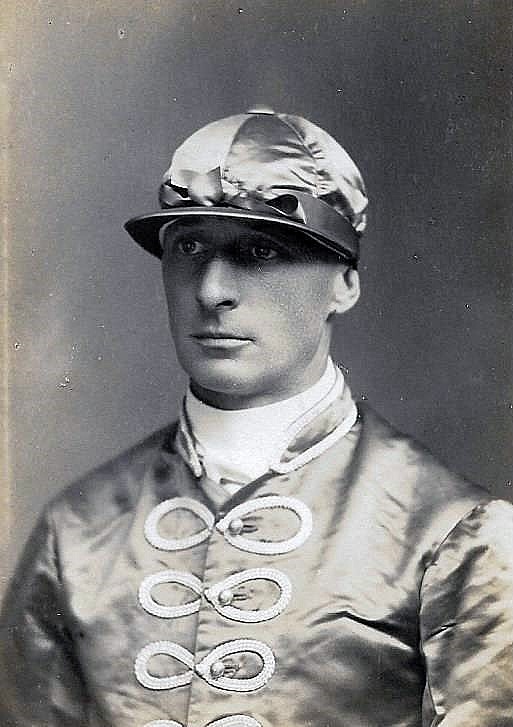
In 1901 on the death of Andrew the estate passed to his son John Johnstone (1881-1935) who was also an accoplished owner, jockey and breeder of horses. The picture shows him in racing silks.
He chose to live at Broadholm the family home of his wife Nancie Jardin Paterson (1889-1933) while his sister Nina McKie Johnstone (1882-1950) occupied Halleaths Mansion. She married Noel Wallace Hickling (1881-1937) a Tea Merchant who died in Shanhai, China. She used the title “Douglas of Newtonairds”
For some years, Mrs Douglas of Newtonairds, the sister of the Laird was influential in Lochmaben affairs. As well as presenting a curling rink to the town in 1911 she donated a tastefully designed drinking fountain to commemorate King Edward VII47. This fountain stood originally in front of the Bruce statue but was moved some years ago to the Townhead.
Mrs Douglas attended the Free Church, but a remark in the minister’s sermon incurred her displeasure so that she, with her lap dog, transferred her allegiance to the Parish Church. During the Great War (1914-1918) she also helped with fundraising efforts for the Home Guard48 and packages for allied Prisoners of War and supported the families of local men who lost their lives in the war.
On the death of John Johnstone, Halleaths passed to his son Andrew John Robert Johnstone (1915–1978) who was born in Shanghai, China and died in Newmarket but is buried in Lochmaben. He was also a keen horseman and took part in races as far away as China and Hong Kong49. The picture shows him meeting Lady Mary Keswick in Shanghai, China in 1938 wearing racing silks under his coat.
He ceded control of Halleaths to the military after the outbreak of World War 2.

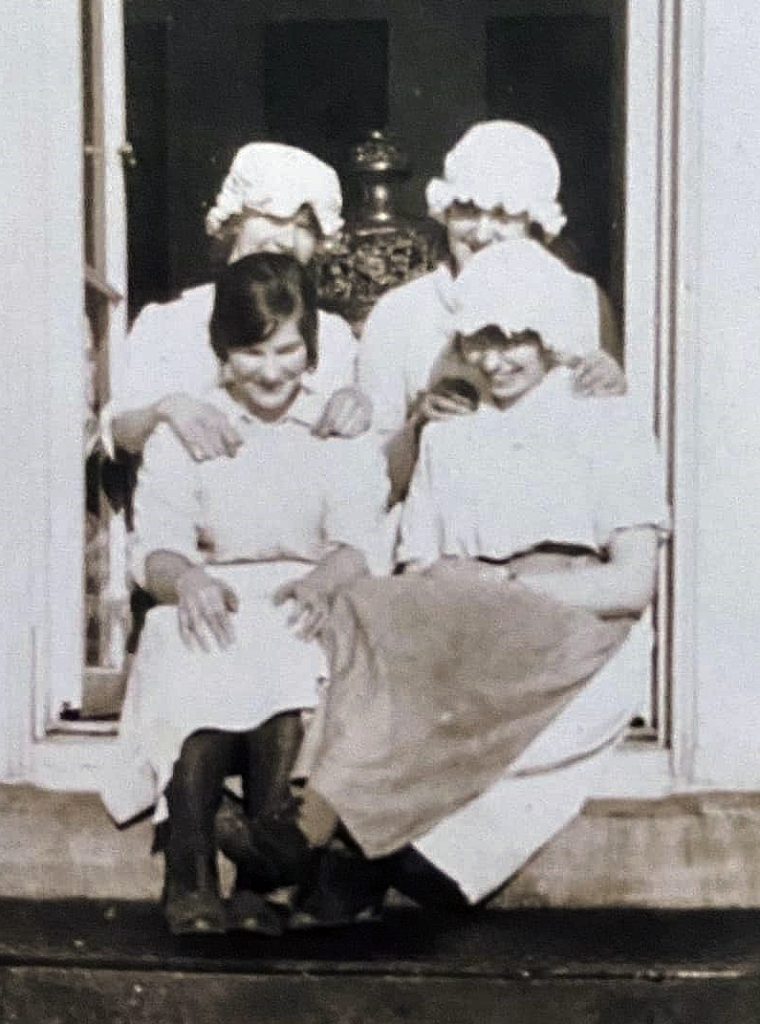
In its prime, the house and estate provided work for many Lochmaben men and women50.
Twelve in the house, three in the garden and many others in the stables, home farm and estate. Examing the 1901 Census has identified local people filled the following occupations;
Groom, Coachman, Gardeners, Housemaids, Kitchenmaids, General Domestics, Farmers, Farm Labourers, Cheesemaker, Dairymen, Dairymaids, General Servants, Gamekeeper, Quarryman (freestone cutter), Mason Journeyman & Apprentice, TablemaidS, Cook, Laundry Maid, Sewing Maid.
The best example of the house is an aerial photograph51 taken in 1929 in which can be seen two tennis courts and a race track near to the stables for the horses.
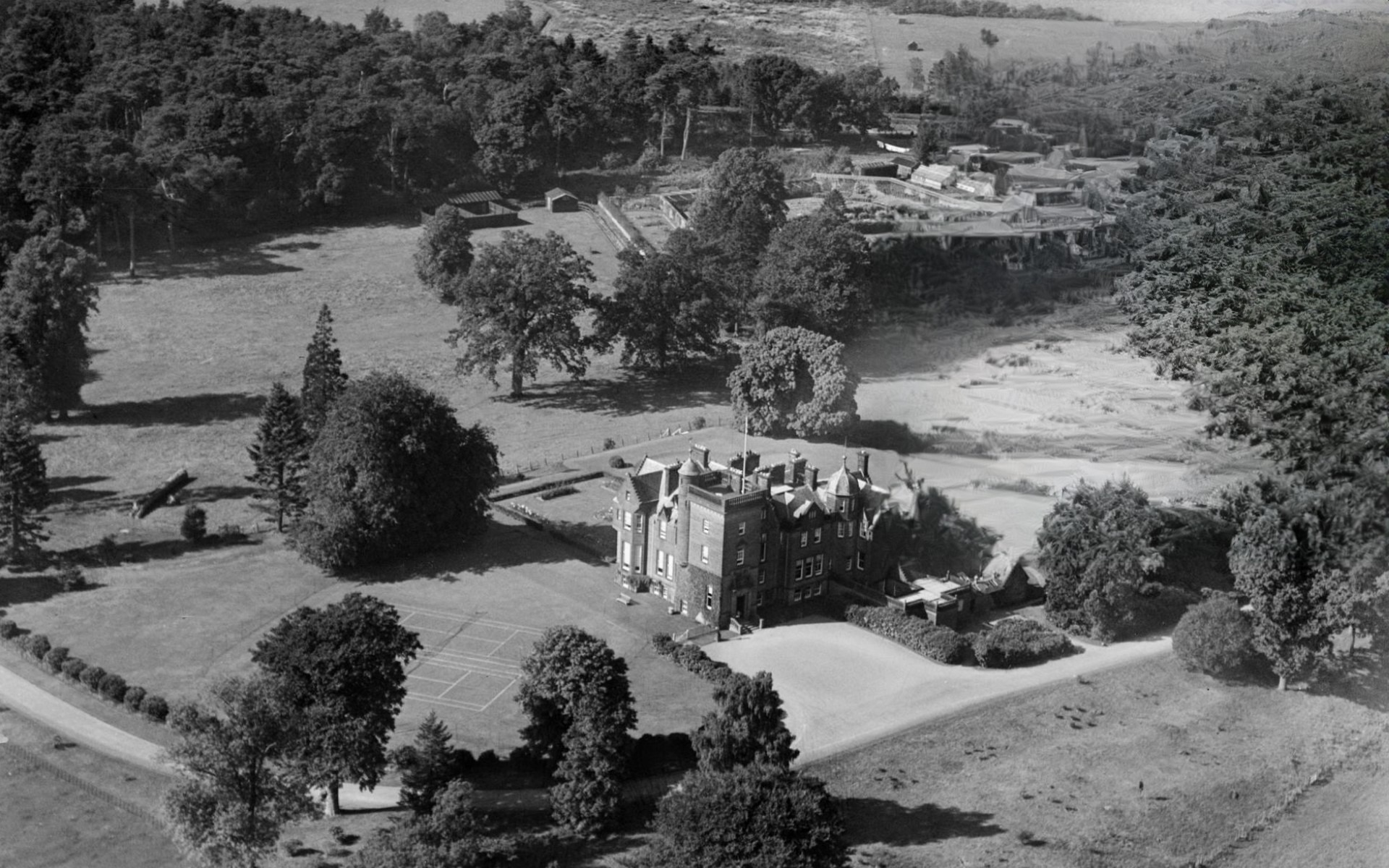
In 1933 John Johnstone extendedextended the fences of his fields into the Castle Loch. This prevented the folk of Lochmaben from walking, as had been their custom, round the loch. A large and representative body of citizens, headed by Dr. T. E. Gilchrist, and including the Provost and Parish Minister, marched round the loch and deliberately removed the offending fences. By what is still considered locally as a miscarriage of justice they lost the subsequent case in the Court of Session.52
Halleaths Army Camp
Britain was not well prepared for World War 2 in the late 1930s due to underinvestment in its military during the previous decades and the appeasement policy of Neville Chamberlain53. The British army was small, the economy was recovering from depression, and air defences were just being developed. The leadership emphasis was on avoiding war rather than actively preparing for it.
It was not until aggressive Nazi policies became impossible to appease that Britain began rapid rearmament. By 1939, Britain’s military remained understrength across the board, but wartime mobilisation and new leadership enabled the country to play a vital role, narrowly surviving threats like the Battle of Britain.
On September 1, 1939, Germany invaded Poland on the false pretext that Poland had carried out a series of sabotage operations against German targets. Britain and France declared war on Germany two days later. The invasion of Poland marked the start of World War 2 in Europe. In the first few months, Germany invaded and occupied Poland and Denmark, Norway, the Netherlands, Belgium, and France also fell to the German war machine.
The British Expeditionary Force (BEF)54faced a significant setback during the early stages of World War II in 1940. The failure occurred during the Battle of France55, which was a part of the larger German Blitzkrieg56 offensive. The BEF and French forces were caught off guard by the speed and intensity of the German invasion of France and the Low Countries.
Despite initial successes, the BEF and its allies found themselves surrounded and outnumbered by German forces. The evacuation of Dunkirk, known as Operation Dynamo57, took place from May 26 to June 4, 1940, allowing the evacuation of over 300,000 British and Allied troops from the beaches of Dunkirk back to Britain.
As part of Britain’s increasing war effort, Halleaths House was taken by the army, specifically by the Regiment Royal Engineers58 No. 8 Training Regiment59 (RETR), under the command of Major J. Patrick Jeffrey (temporarily promoted to Lt. Colonel), which played a vital role in preparing personnel for service in the Royal Engineers, the British Army’s engineering branch. The training area was known as the Torthorwald Dalton Training Area60 and encompassed 1000 acres (about 16 square miles).
The camp was also home to the Auxiliary Territorial Service61, the women’s branch of the British Army during the Second World War. It was formed on 9 September 1938, initially as a women’s voluntary service, and existed until 1 February 1949, when it merged into the Women’s Royal Army Corps. The ATS had its roots in the Women’s Auxiliary Army Corps, which formed in 1917 as a voluntary service.
The following image is based, in part, on a hand-drawn map62 of the army camp as of September 1942 and pieced together from other diverse sources.
SOLDIER DROWNED AT HALLEATHS.
20 May 1945
On Sunday afternoon, about half- past three, a number of soldiers from Halleaths Camp were engaged in bathing in the river Annan opposite the camp.
One of their number, Sapper Leslie Shilling, of the Royal Engineers, whose home is at 9 Ashley Villas, East Boldon, County Durham, was unable to swim and got into difficulties after diving from a raft moared in the river. His companions made every effort to find him and ultimately recovered the body from a pool nine feet deep. Artificial respiration was immediately tried, but although it was continued for an hour it was unsuccessful.
He was nineteen years of age, and the funeral, which was of a military nature, took place to his home town of East Boldon.63
The green area shows the overall extent of Halleaths Camp and the Prisoner of War Dryfeholm Camp / Base Camp No. 617.
The individual areas are outlined in red, numbered and identified as follows:
- Headquarters and Officer accomodation in Halleaths House
- Quartermasters64 Stores
- Military Intelligence Unit65
- Dental Centre
- Gymnasium, Drill Hall, Parade Ground
- NAAFI (Navy, Army and Air Force Institutes)
- Assault Course
- Firing Ranges
- Depot
- Driving and Motor Pool
- Auxiliary Territorial Service66 (ATS)
- POW Compound – 617 Dryfeholm Camp, Lockerbie – built here in 1942 to house up to 450 German and Italian prisoners.
The training covered a range of skills, including combat engineering, demolition, bomb disposal, field engineering, map reading, surveying, and water supply, ensuring soldiers were well-equipped for the diverse and evolving challenges of modern warfare.
The army training staff also provided training to its sister service, the Royal Air Force, with airfields at Annan, Heathhall and Carlisle in close proximity.
Below are a series of photographs showing RAF Airfield Construction Squadron personnel being trained variously in mine detecting, defusing, boobytrapping and destruction. All pictures taken 2 July 1944 by Sergeant Travis. Photographs published by courtesy of the Imperial War Museum67.
Find that mine!
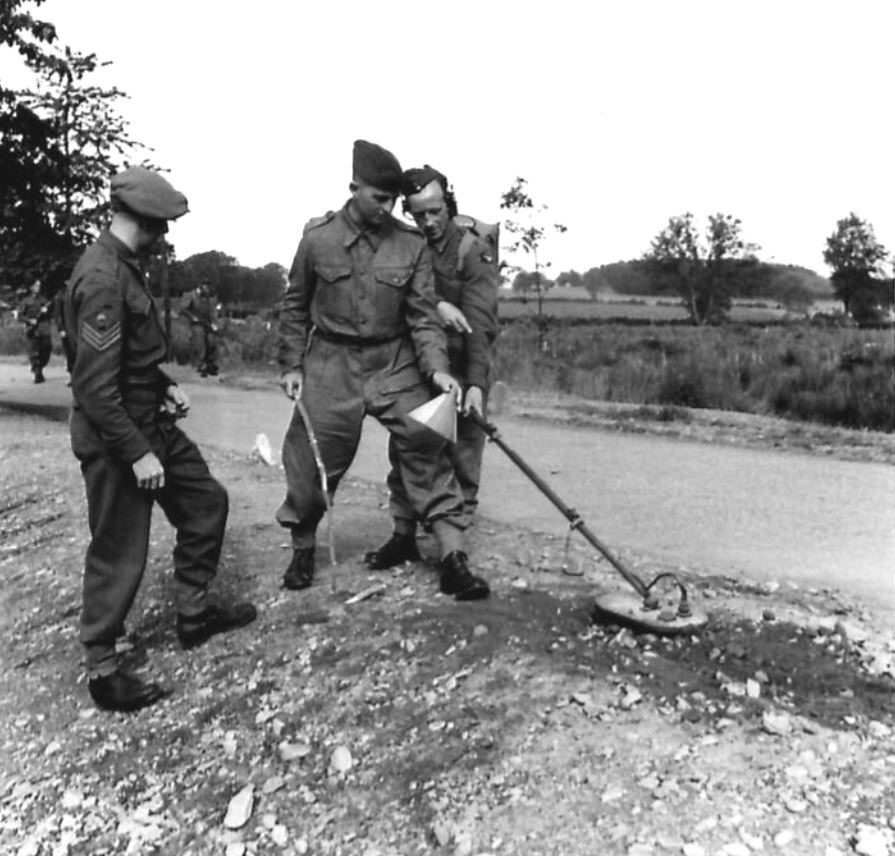
Uncover that mine!
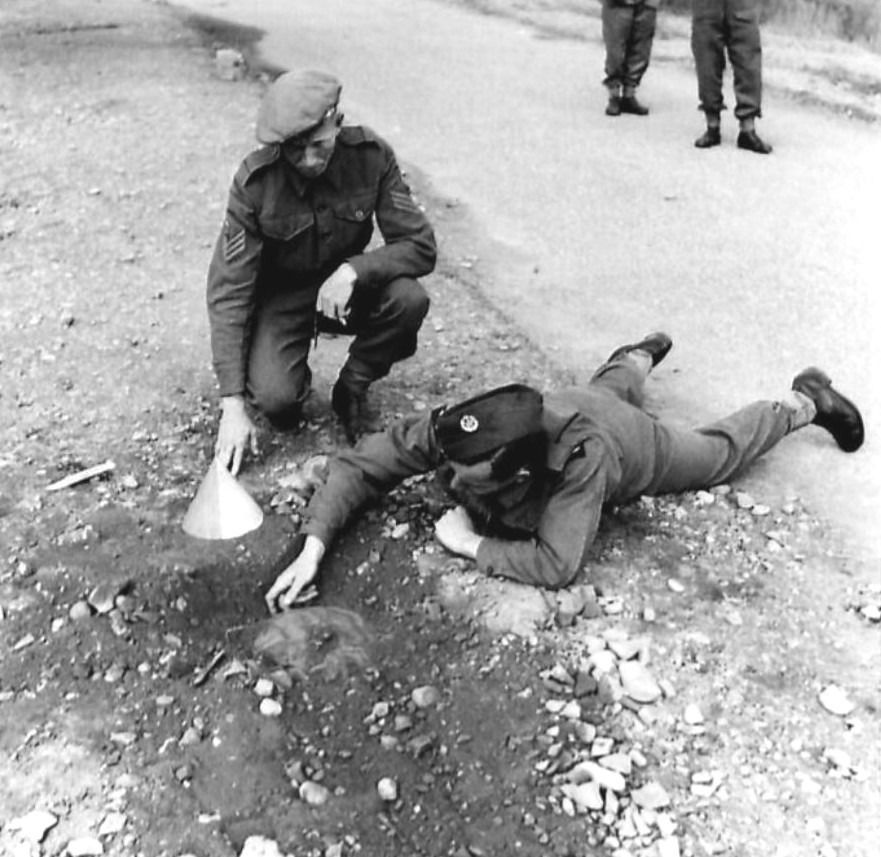
Booby trap that Mine!

Ready for Destruction!

Bang!
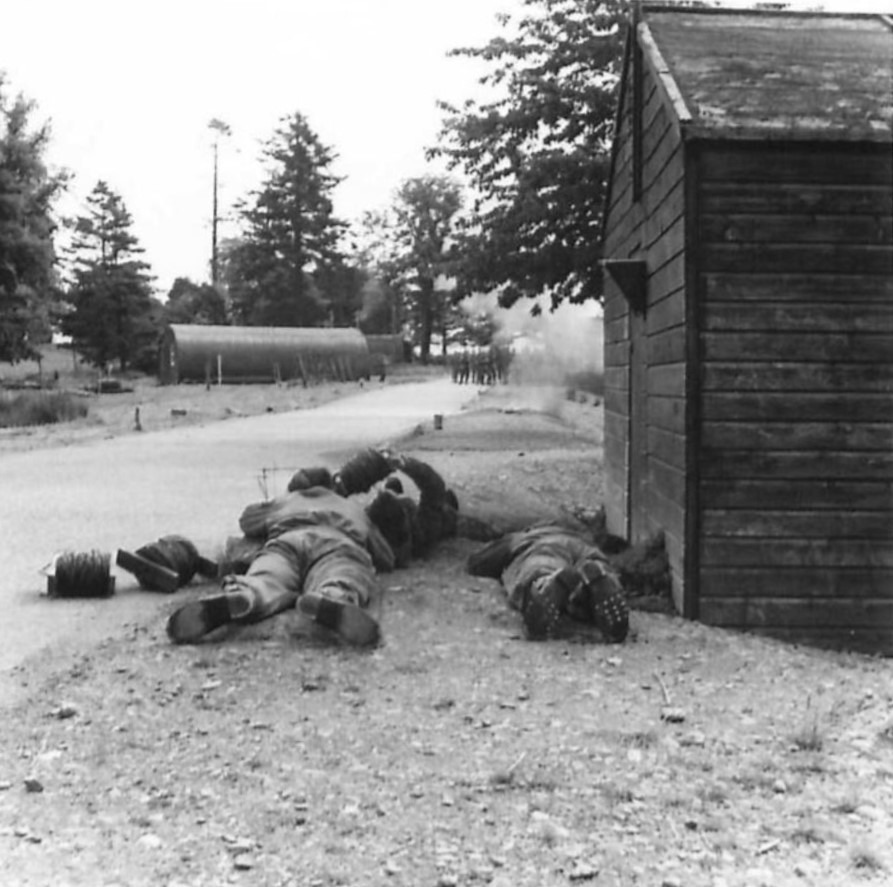
Fence it In – or Out!
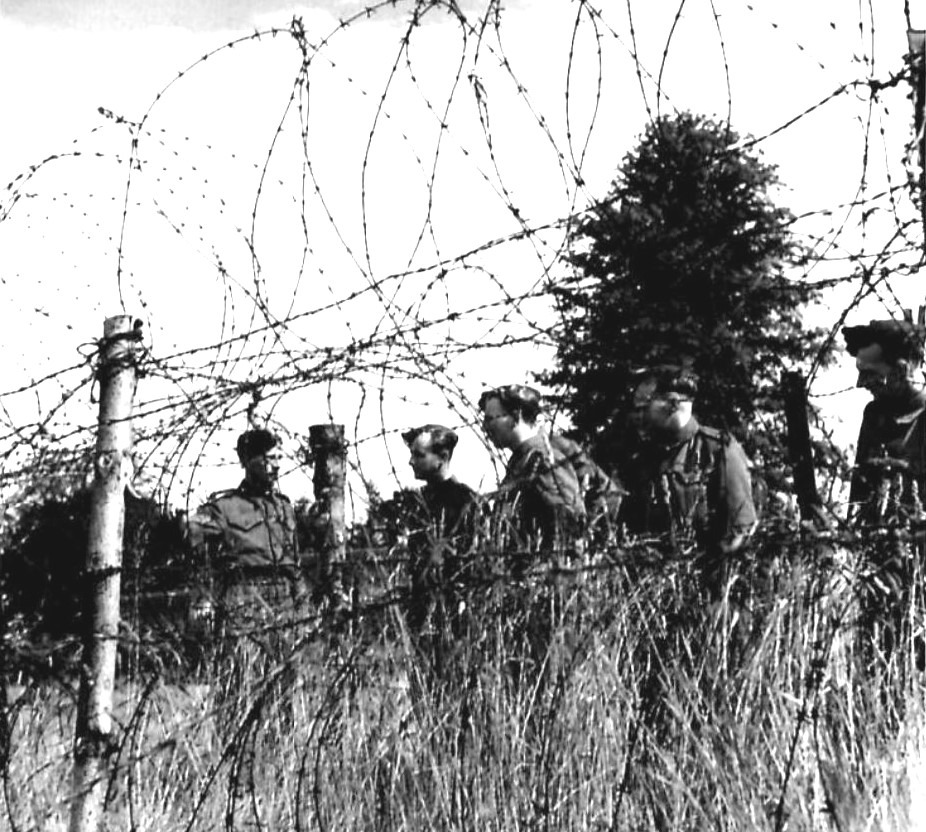
Revetment Building!
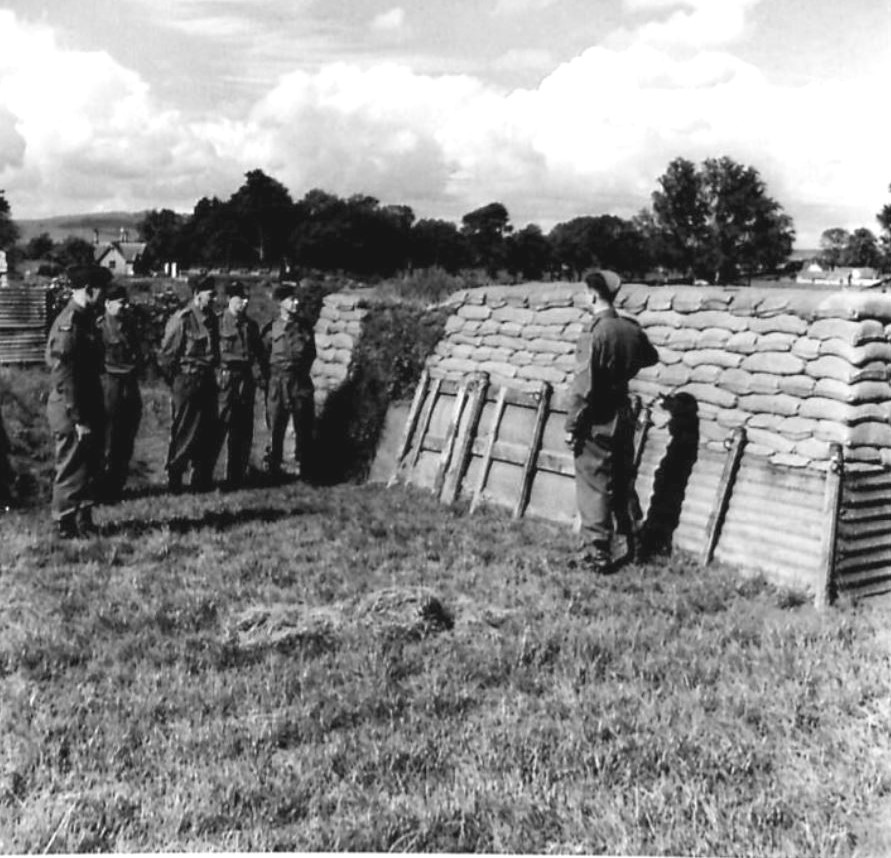
Slit Trench!

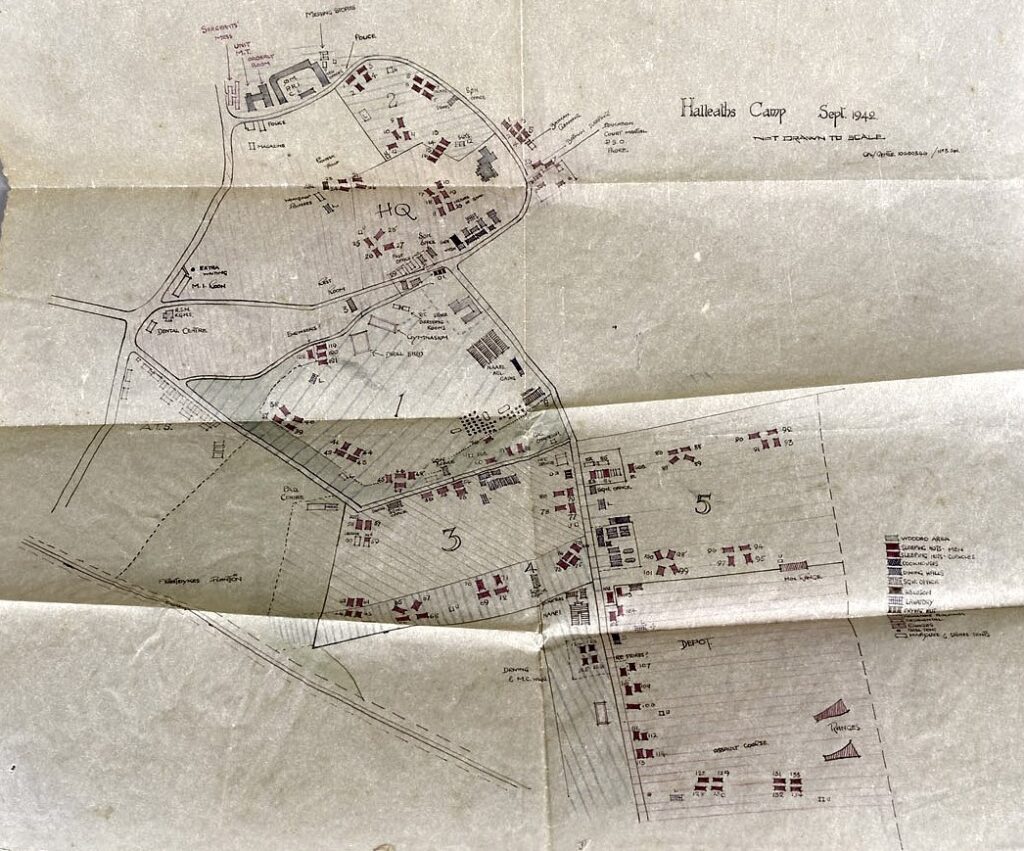
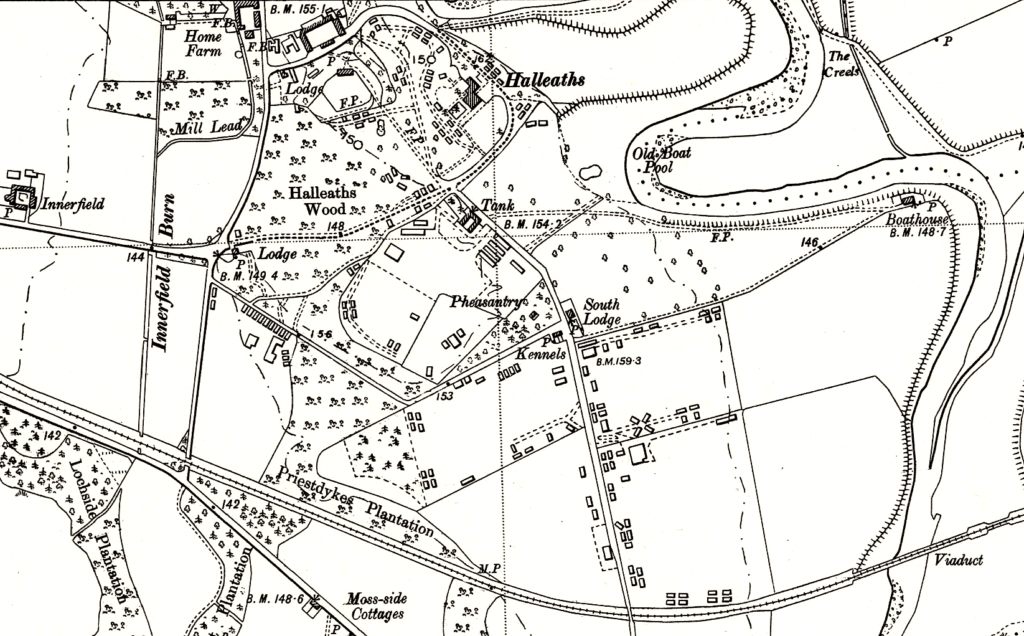
10: Ordnance survey map prepared in 1948 but published in 195268 which shows some of the camp, much having been removed prior to the preparation of the map.
The Reconnaissance Corps69 (RC), motto ‘Only the Enemy in Front‘, was established in January 1941. Its units were tasked with gathering tactical information for infantry divisions, scouting ahead and screening the flanks of these formations as they advanced. The Corps was equipped with Bren Carriers, armoured cars, light tanks, jeeps and lorries.
The RC recruited from across the Army, but its soldiers were expected to be adaptable and resourceful. They also had to pass an intelligence test before being trained as drivers, wireless operators, mechanics or assault infantrymen. Most RC soldiers could perform at least two of these roles.
The birth of the Reconnaissance Corps also brought the necessity for the establishment of training centres for its personnel. Winchester provided a temporary first home for a Reconnaissance Training Centre but as the Corps expanded three training centres were created. These were Nos 1 and 2 Reconnaissance70 Training Centres at Halleaths Camp and at Scarborough as well as a Tactical Training School at Annan.
The inhabitants of the Lochmaben watched with interest as their lochs, principly the Kirk and Castle Loch’s were assaulted by tmilitary force.
The lochs were rapidly bridged by pontoons71 and landing craft72 as the soldiers trained for the invasion of Europe, yet to come.
Wartime reflections
by Stuart Roxburgh of Lochmaben
I was born 5 months into the war. The soldiers would take me out in their large boats on the Kirk loch as a child, the boats were left turned upside down on the grass below where the toilets now stand when not in use.
I had many a kiss with a girl there at around age 5 or 6.
The drive up to the camp from Innerfield was bordered with Sweet William (I picked a few after the camp was closed, for my Mum).
We had some soldiers for tea every week and they used to bring me toys they had made for me.
Amie and Birdie were my favourite squaddies, they were from Lancashire.
The best toys however, were made for me by the German pows. Panzer tanks and boats carved out of wood and painted in authentic camouflage. Again, I had 2 favourites, Herman and Rudi who took me round the countryside in the lorry they were driving for Mair the coalman.
I can still smell the dreadful odour of the food being cooked for the troops. There are still many signs of the existence of the camp, the lavatory opposite the big house and the concrete bases of the Nissen huts in the small wood overlooking the river to name but a few.
LOCHMABEN CANTEEN
Served Half-Million Cups Of Tea
In 1945 the Army Canteen at Halleaths, operated by local ladies under the supervision of Mrs Campbell, closed having served the camp inhabitants over half a million cups of tea.
Established in 1940, it was staffed by ladies from Lochmaben. It closed in December following a Christmas party held in the canteen to thank the local women. The soldiers decorated the canteen, while entertainment was provided by local musicians Mr W. McGhie, Francis McGhie and Miss Ray Broatch. Additionally Miss Jardine and Miss J McGarth of the ATS sang solos73.
A wooden pier, built on the edge of the Kirk Loch (golf course) was a staging point for crossing the loch in assault craft and storming up the back gardens of the houses in Bruce Street.
Royal Engineers also practised building Baillie Bridges from the same wooden jetty
The soldiers and local communities lived alongside each other in relative harmony. Many of the soldiers were themselves parents and a long way from home.
The story of one local child growing up in time of war is that of Stuart Roxburgh – a long time Lochmaben resident.
Halleaths Prisoner of War Camp
Following Dunkirk, work began identifying and preparing locations to house captured prisoners of war. One such location was Dryfeholm Camp or Base Camp No. 61774, as it was known, was incorporated within Halleaths Army Camp in 1942 to house up to 450 German and Italian prisoners.
What would happen if the UK’s prison population suddenly increased by 400,000 people? That’s what occurred between 1939 and 1948, when thousands of Germans, Ukranians75 and others became Britain’s prisoners of war)).
Researching POW camp locations proved a challenge. Few official lists of camps or prisoners remain from that time, most camps were temporary and pulled down after the war. Some have subsequently been built on. Most modern camp lists are based on archaeological work – ironic when the camps existed a mere 70 years ago. Records from the time give an insight into camp life and sometimes reveal the name of a camp, but often the documents didn’t reveal the actual address, and prisoners were not allowed to write their camp address on any letters they sent home76.
The end of the Era
Recorded in Hansard77 Mr. Niall Macpherson, Member of Parliament for Dumfriesshire, asked the Secretary of State for War two questions about Halleaths Army Camp
- On 18 December 1947 he asked “…whether, in view of his decision to close Halleaths Camp, Lockerbie, at present occupied by No. 8 Training Regiment, R.E., he will now declare that he has no further interest in the use of the area known as Torthorwald range for military purposes.”. A reply was given by Mr Shinwell “Training rights over 1,000 acres of the area known as Torthwald Dalton are being sought by my Department for use by Territorial Army and Army Cadet units. This proposal, which would not involve firing with live ammunition, or restriction of public access, will be considered by the Inter-Departmental Committee on Services’ Land Requirements.”78
- On 27 June 1949, ”…why the material available for disposal on the breaking up of Halleaths Camp, Lockerbie, is not being offered for sale locally…” The answer given was “The materials recovered from the breaking up of Halleaths Camp are not being offered for sale, either locally or elsewhere, as they are required for further use by the War Department.”79
Eventually, in August 1948, the camp was so badly flooded by the River Annan and it was abandoned.
The Royal Engineers No. 8 Regiment left the camp in 1947 and relocated to Elgin in Morayshire ,where it remained until 1954, when it was disbanded80.
By this time Lt. Colonel J Patrick Jeffrey was commanding officer of 51st Highland Division, Royal Engineers (Territorial Army) and on February 1, 1951 he was appointed Battallion Colonel81.
A Sad End and a New Beginning
During the Second World War, the government requisitioned country houses across the United Kingdom for the war effort. No house was exempt, with the grandest stately homes re-purposed to house everything from schools to maternity homes, from military hospitals to war supply depots.
The requisitioning was enabled by the Emergency Powers (Defence) Act 193982 and Defence (General) Regulations 193983, it allowed the government to take control of land and property deemed crucial for the war effort.
In all 14.5 million acres of land, alongside industrial and non-industrial premises, were requisitioned. The War Office alone took over 580,847 acres.
Compensation was recognised from the outset under the Compensation (Defence) Act 193984. However, it was based on pre-war values, often leading to disputes and perceived unfairness.
Examples of requisitioned property would be Airfields with numerous airfields built on requisitioned land, becoming vital for the air war. The Airfields at Annan, Carlisle and Heathhall are local examples
More locally was the need for the creation of the Torthorwald Dalton Training area impacting agricultural and rural communities, such was the fate of Halleaths.
Post-war situation
After the war, a gradual process of de-requisitioning began, returning properties to their owners which led to compensation disputes where many owners felt the compensation was inadequate, leading to disputes and prolonged processes. Some requisitioned land retained its new military or public purpose, while others reverted to pre-war uses. The experience of requisitioning left a mark on communities and land use patterns, shaping postwar development.

The impact on Halleaths was substantial and the military intended to keep it as a training area, however extensive flooding in 1948 led to the closure of the estate and its subsequent breakup and selling off by the state, the laird was never to return having accepted the compensation given.
In 1952, after wartime occupation by the Army, the mansion was demolished. Little remains of the estate save the magnificent stables, the walled garden, the gardener’s cottage, and the West Lodge which are now private residences. Other parts of the estate were sold for industrial and agricultural uses.
- https://scotlandsplaces.gov.uk/digital-volumes/historical-tax-rolls/land-tax-rolls-1645-1831/land-tax-rolls-dumfriesshire-volume-05/46[↩]
- https://en.wikipedia.org/wiki/Robert_the_Bruce[↩]
- The Clerks of the day used ‘de’ to define a persons ownership of (usually land[↩]
- https://www.scotland.org.uk/kings-queens-of-scotland/edward-balliol[↩]
- https://clancarrutherssociety.org/2022/03/12/clan-carruthers-the-house-of-holmains-our-chiefly-line/[↩]
- https://cotr.ac.uk/robert-charters/acts-edward-balliol-king-scots-1332-56/[↩]
- https://en.wikipedia.org/wiki/Archibald_Douglas,_4th_Earl_of_Douglas[↩]
- https://clancarrutherssociety.org/2018/09/23/carruthers-of-mouswald/[↩]
- https://clanmaxwellsociety.com/a-brief-history/[↩]
- https://en.wikipedia.org/wiki/Court_of_Exchequer_(Scotland)[↩]
- Distrain – to constrain by seizing and holding goods, etc., in pledge for rent, damages, etc., or in order to obtain satisfaction of a claim[↩]
- Records of the Carruthers Family Compiled by A. Stanley Carruthers, F.S.A.IScot.), and R. C. Reid https://electricscotland.com/webclans/atoc/recordsofcarruthers.pdf[↩]
- https://reivers.info/wardens-of-the-marches/[↩]
- https://archive.org/details/lordwardensofmar00peasuoft/page/46/mode/2up[↩]
- https://www.tandfonline.com/doi/abs/10.1179/174587006X86783[↩]
- https://carothers-carruthers.com/kirtle.html[↩]
- https://en.wikipedia.org/wiki/Battle_of_Lochmaben_Fair[↩]
- Scots word meaning return[↩]
- History of the Johnstones 1191-1909 with Descriptions of Border Life by C. L. Johnstone author of “Historical Families of Dumfriesshire” page 68-69: . https://electricscotland.com/webclans/htol/historyofjohnstons.pdf[↩]
- https://scotlandsplaces.gov.uk/digital-volumes/historical-tax-rolls/land-tax-rolls-1645-1831/land-tax-rolls-dumfriesshire-volume-05/46[↩]
- FEU: (Scots Law) A free and gratuitous right to lands made to one for service to be performed by him; a tenure where the vassal, in place of military services, makes a return in grain or money. https://www.thefreedictionary.com/Feu[↩]
- https://en.wikipedia.org/wiki/Clan_Kennedy[↩]
- https://en.wikipedia.org/wiki/Wars_of_Scottish_Independence[↩]
- History of the Johnstones 1191-1909 With descriptions of Border Life C. L Johnstone author of “Historical Families of Dumfriesshire W. & A. K. Johnstone Limited, Edina Works, 2 Saint Andrew Square, Edinburgh. https://electricscotland.com/webclans/htol/historyofjohnstons.pdf[↩]
- Archibal Johnston, Lord Wariston (1611-1663) https://en.wikipedia.org/wiki/Archibald_Johnston[↩]
- Messengers at arms, who are the ordinary executors of all the King’s letters; or by macers of the Court of Justiciary, to whom the salutation of criminal letters, and also of the letters of diligence which pass on indictment, is specially addressed.[↩]
- https://archive.org/details/annandalefamilv100fras[↩]
- History of the Johnstones 1191-1909 with Descriptions of Border Life by C. L. Johnstone author of “Historical Families of Dumfriesshire” page 24: . https://eHistory of the Johnstones 1191-1909lectricscotland.com/webclans/htol/historyofjohnstons.pdf[↩]
- https://www.bbc.co.uk/arts/robertburns/biography.shtml[↩]
- https://archive.org/details/bim_eighteenth-century_a-collection-of-original_1762_2[↩]
- https://library.artstor.org/#/public/SS33053_33053_791431[↩]
- The history of the Scottish Church, Rotterdam (1832) Page 223-227 of https://archive.org/details/historyofscottis00stevuoft/page/222/mode/2up[↩]
- https://www.scotsintchurch.com/[↩]
- The Transactions Journal of Proceedings Dumfriesshire and Galloway Natural History and Antiquarian Society founded November 1862 Page 83 Communion Tokens. H. A. Whitelaw https://electricscotland.com/history/dumfries/transactions21.pdf[↩]
- https://www.lochmabenchurchofscotland.co.uk/[↩]
- https://digital.nls.uk/directories/browse/archive/85568178[↩]
- https://digital.nls.uk/directories/browse/archive/85584676[↩]
- https://en.wikipedia.org/wiki/History_of_Jardine_Matheson_%26_Co.[↩]
- https://scotlandsplaces.gov.uk/digital-volumes/historical-tax-rolls/land-tax-rolls-1645-1831/land-tax-rolls-dumfriesshire-volume-05/46[↩]
- https://en.wikipedia.org/wiki/Merk_(coin)[↩]
- https://en.wikipedia.org/wiki/History_of_Jardine_Matheson_%26_Co.[↩]
- https://www.bmj.com/content/360/bmj.k972[↩]
- https://www.railscot.co.uk/companies/D/Dumfries,_Lochmaben_and_Lockerbie_Railway/[↩]
- https://www.thejockeyclub.co.uk/epsom/events-tickets/epsom-derby/[↩]
- https://en.wikipedia.org/wiki/Pretender_(horse)[↩]
- https://www.thejockeyclub.co.uk/newmarket/events-tickets/guineas-festival/[↩]
- https://www.biography.com/royalty/edward-vii[↩]
- https://www.iwm.org.uk/history/the-real-dads-army[↩]
- https://keylocks.com/john-johnstone/[↩]
- Notes from Dr Jack Wilson’s books[↩]
- https://canmore.org.uk/collection/1256894[↩]
- Closed Record in Action at the instance of John Johnstone of Halleaths against Thomas Ernest Gilchrist, et al, 27th February 1934.[↩]
- https://encyclopedia.ushmm.org/content/en/article/neville-chamberlain[↩]
- https://en.wikipedia.org/wiki/British_Expeditionary_Force_(World_War_I)[↩]
- https://www.britannica.com/event/Battle-of-France-World-War-II[↩]
- Blitzkrieg or Bewegungskrieg is a word used to describe a combined arms surprise attack.[↩]
- https://www.iwm.org.uk/history/what-you-need-to-know-about-the-dunkirk-evacuations[↩]
- https://military-history.fandom.com/wiki/Corps_of_Royal_Engineers[↩]
- https://military-history.fandom.com/wiki/8_Regiment_RLC[↩]
- https://hansard.parliament.uk/Commons/1947-12-18/debates/234001a3-7db9-4973-b5ab-4bcac7e7f94f/TrainingAreaTorthwaldDalton[↩]
- https://www.nam.ac.uk/explore/auxiliary-territorial-service[↩]
- https://www.the-saleroom.com/en-gb/auction-catalogues/special-auction-services/catalogue-id-srspe10222/lot-13c54b0e-058f-45e2-a8f5-a7c900f004de[↩]
- Dumfries and Galloway Standard and Advertiser 29 Decmber 1945[↩]
- Quartermaster is generally a relatively senior soldier who supervises stores or barracks and distributes supplies and provisions.[↩]
- Responsible for collecting, analysing and disseminating military intelligence and also for counter-intelligence and security.[↩]
- https://www.nam.ac.uk/explore/auxiliary-territorial-service[↩]
- https://www.iwm.org.uk/[↩]
- https://maps.nls.uk/view/75503144[↩]
- https://www.nam.ac.uk/explore/reconnaissance-corps[↩]
- https://ww2talk.com/index.php?threads/recce-number-one-training-camp-jan-41.76100/[↩]
- A pontoon bridge, also known as a floating bridge, uses floats or shallow-draft boats to support a continuous deck for pedestrian and vehicle travel.[↩]
- Landing craft are small and medium seagoing watercraft, used to convey a landing force from the sea to the shore during an amphibious assault.[↩]
- Dumfries and Galloway Standard and Advertiser 29 December 1945[↩]
- The information on the POW camp held by Canmore appears to be inaccurate and does not match the existing mapping information[↩]
- No. 68 Halmuir Farm Camp, Lockerbie – after the war, the camp was used for former Ukrainian Prisoners of War who could not return home[↩]
- https://www.theguardian.com/news/datablog/2010/nov/08/prisoner-of-war-camps-uk[↩]
- Hansard is the official record of the proceedings of the UK Parliament[↩]
- https://hansard.parliament.uk/Commons/1947-12-18/debates/234001a3-7db9-4973-b5ab-4bcac7e7f94f/TrainingAreaTorthwaldDalton[↩]
- https://hansard.parliament.uk/Commons/1949-06-27/debates/b6a67fcc-4acb-40d6-b0d3-937c86310369/HalleathsCampLockerbie[↩]
- https://british-army-units1945on.co.uk/royal-engineers/regiments—major-units/8-regiment.html[↩]
- https://www.thegazette.co.uk/London/issue/39404/supplement/6448[↩]
- https://www.lawteacher.net/acts/emergency-powers-defence-act-1939.php[↩]
- https://en.wikipedia.org/wiki/Emergency_Powers_(Defence)_Act_1939[↩]
- https://www.legislation.gov.uk/ukpga/Geo6/2-3/75/contents[↩]
